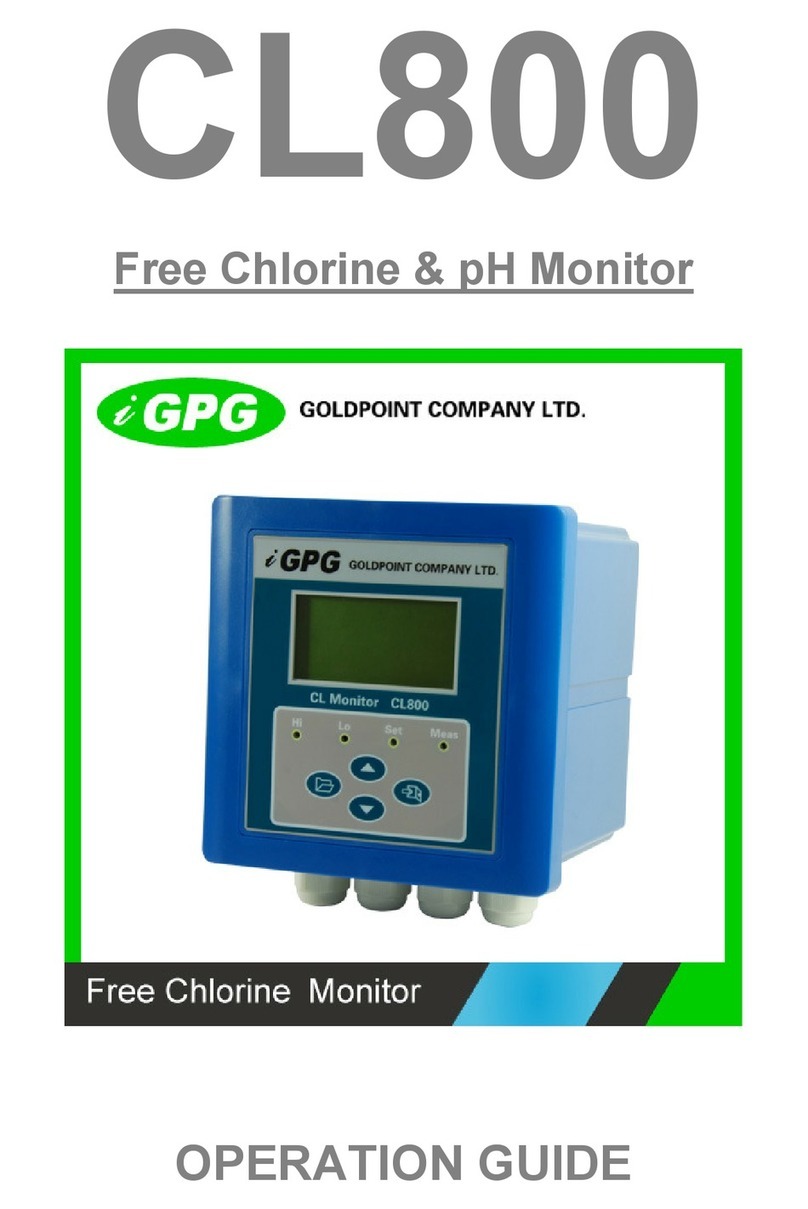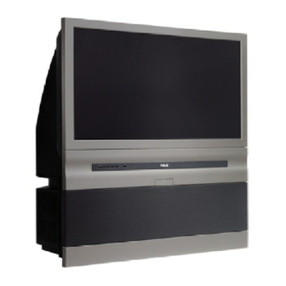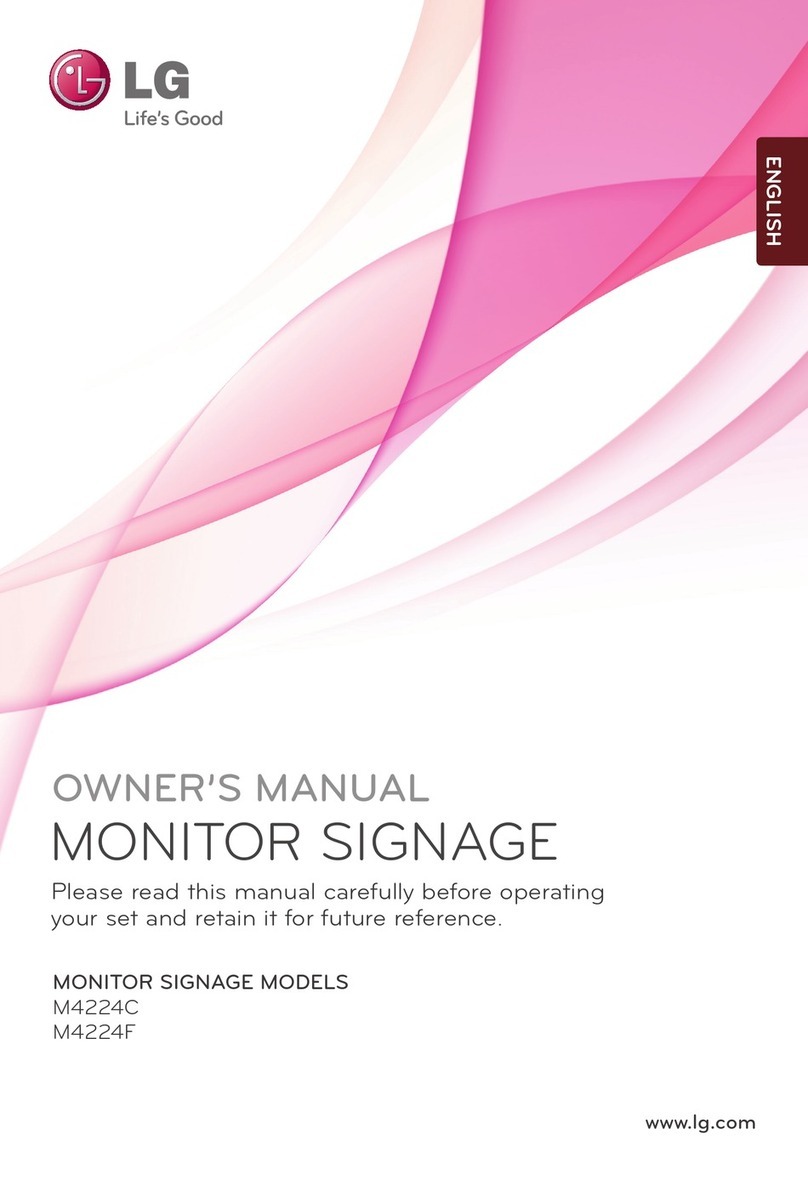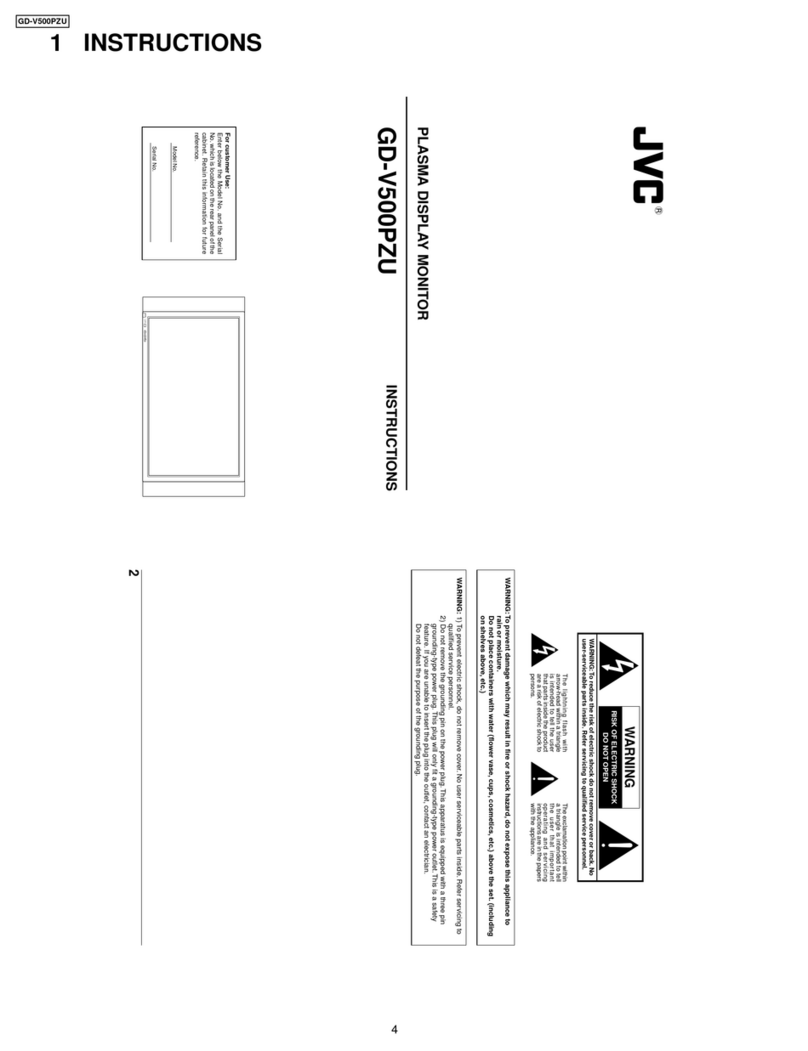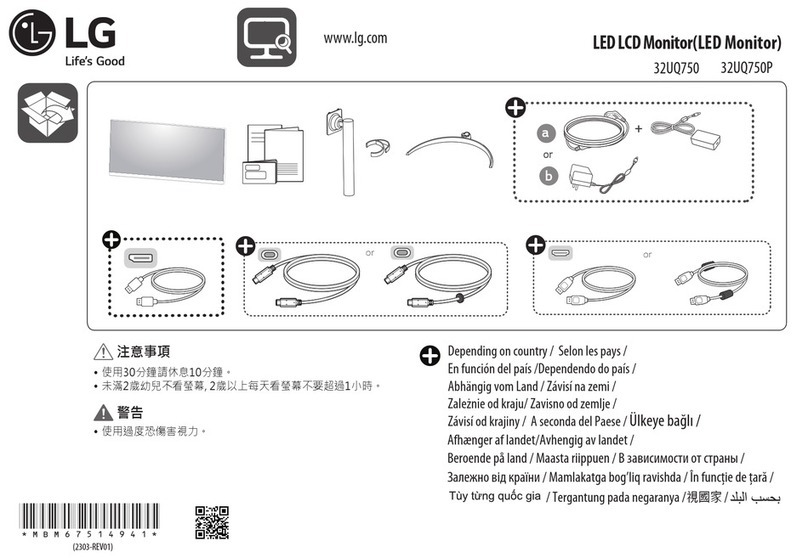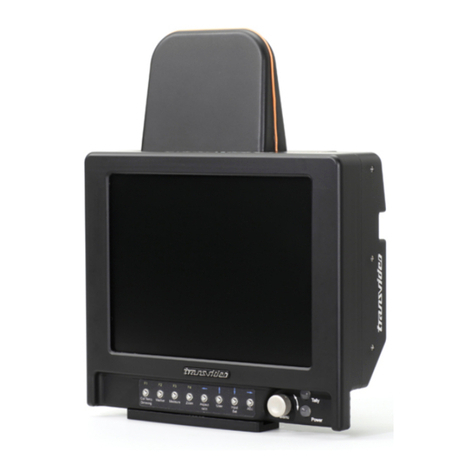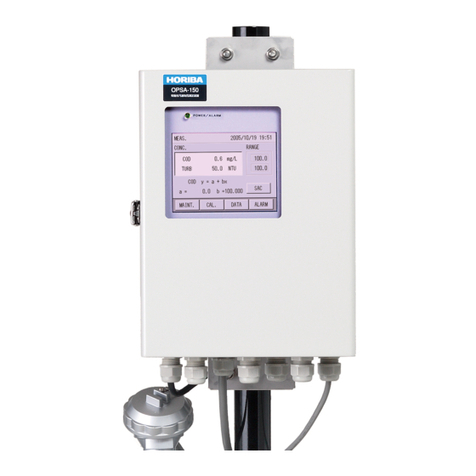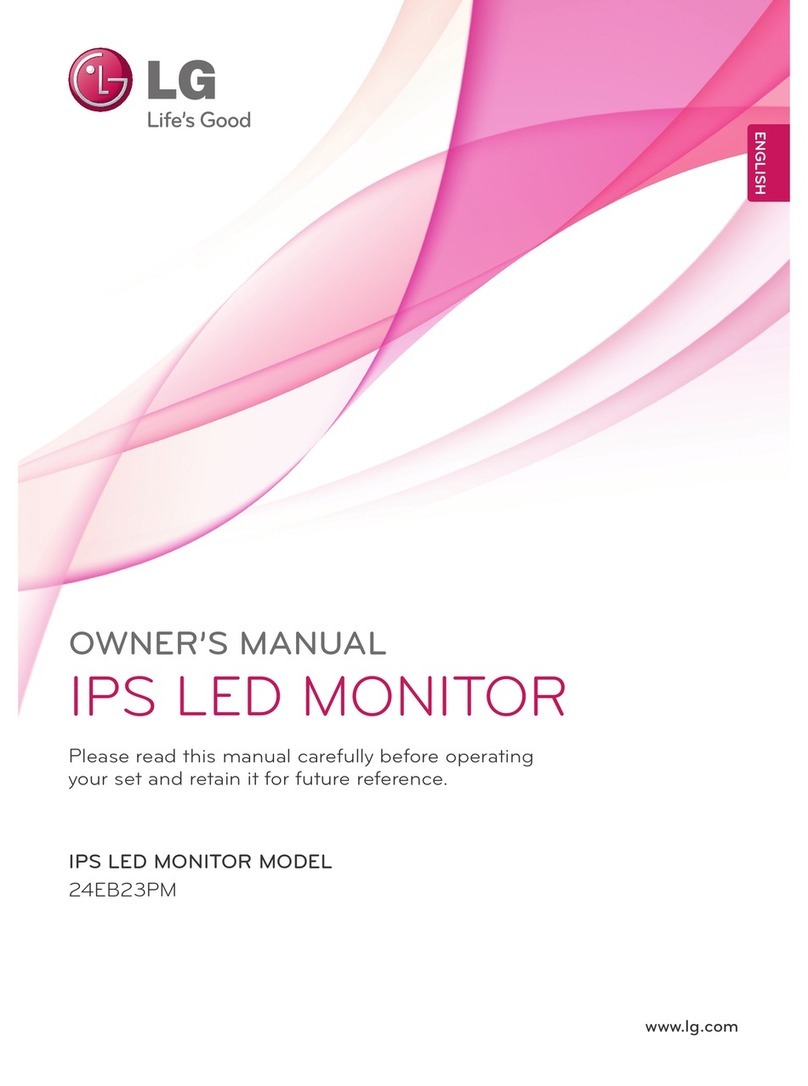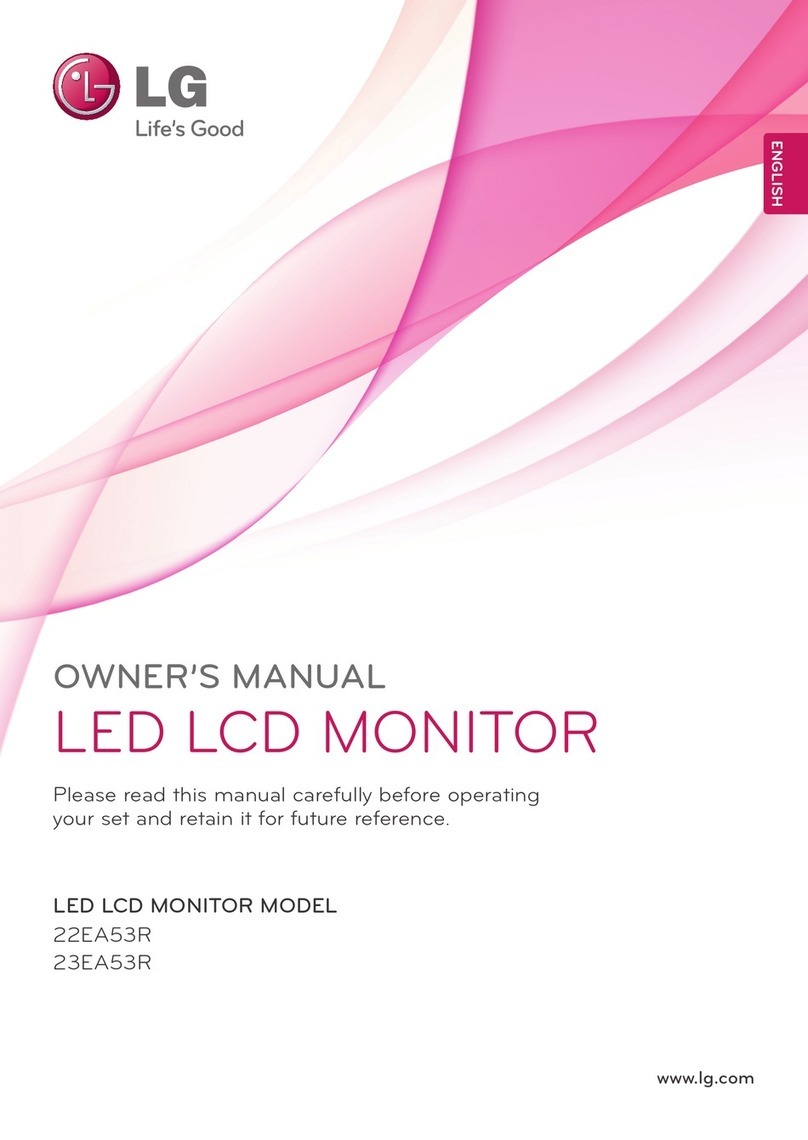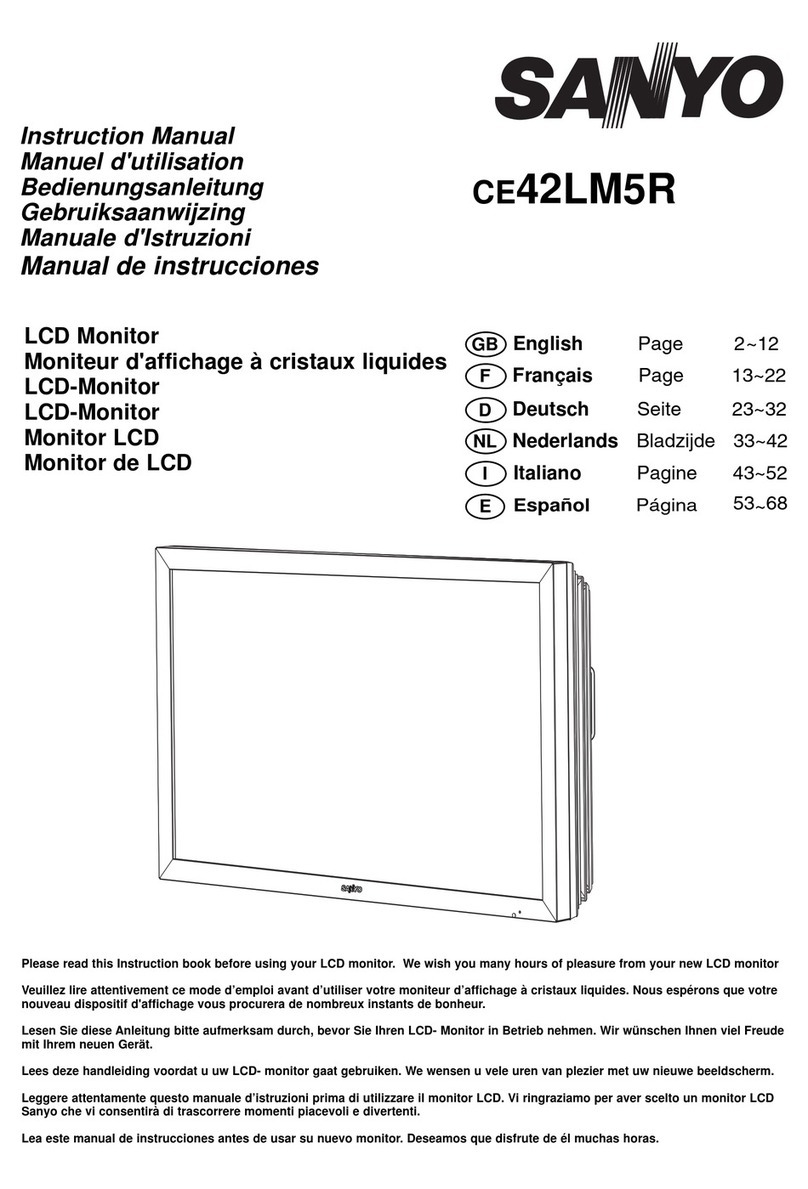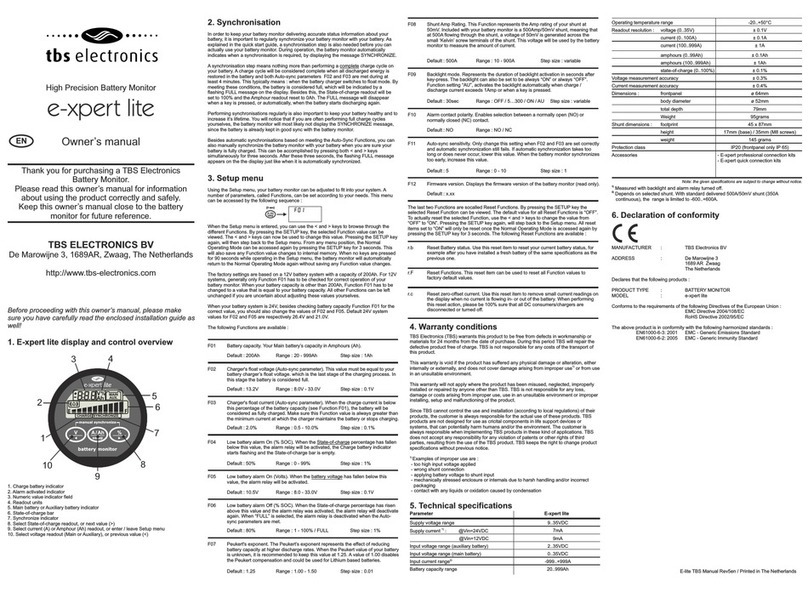GPG P260 User manual

P260
pH / REDOX MONITOR
OPERATION GUIDE

1
CONTENTS
1.
INTRODUCTION.......
2
2.
FEATURES AND TECHNICAL SPECIFICATIONS.
…
2
2.1
Features........
2
2.2
Technical S ecifications........
2
3.
INSTALLATION.....
3
3.1
Dimension........
4
3.2
Panel Cut-out.......
4
3.3
Connection...........
5
4.
MENU STRUCTURE....
6
5.
SETTING AND OPERATION......
9
5.1
User Interface and Descri tion.........
9
5.2
Parameter Setting and O eration.........
10
5.2.1
Set Alarm....
11
5.2.2
Calibration..........
13
5.2.3
Tem erature Com ensation....
16
5.2.4
Set Current Out ut........
17
5.2.5
Measurement Mode......
19
5.2.6
Restore Factory Setting....
19
6.
ERROR CODES...........
20
7.
SENSOR.....
21
8.
WARRANTY...
23
9.
STANDARD CONFIGURATION.....
24
10.
OPTIONAL CONFIGURATION.......
24

2
P260
Intelligent On-line PH / REDOX(ORP) M nit r
1. INTRODUCTION
The P260 is a micro rocessor controlled H and Redox measurement
instrument. The unit utilizes a multifunction LCD to dis lay readings and
rovide feedback to the user. It is available with different o tion to
rovide fully configurable control, alarm and feedback with u to two
relays and 0/4-20mA current out ut sources. It can be used to detect the
H, ORP value of the solution in chemical, etroleum, rubber, a er,
tobacco, alcohol, sugar, food, mining, smelting, iron and steel, ower
generation, harmaceuticals, water treatment and other industries.
2. FEATURES AND TECHNICAL SPECIFICATIONS
2.1 Features
(1) 3-1/2 LCD digital with back-lit dis lay
(2) Measured rocess H, redox, tem erature
(3) Acce ts H glass or antimony and Redox sensors
(4) 0 ~ 100℃ automatic/manual tem erature com ensation
(5) Manual or Automatic buffer adjustment
(6) Restore factory setting function is available
(7) Galvanic se aration between in uts and out uts and su ly voltage
(8) Different in ut for excellent noise rejection
(9) High and low rogrammable alarm, 250V/10A relay out ut
2.2 Technical Specificati ns
(1) Ranges of measurement:0.00~14.00PH / 0~±2000mV / 0~100℃
(2) Accuracy:±0.1 % PH / ±0.1 % mV / ±0.2℃
(3) Linearity:±0.1% of range
(4) Re eatability:±0.1% of range
(5) Tem erature com ensation ty e:Auto / manual 0℃ to 100℃

3
(6) Alarm Out ut:Two relays out uts (250V/10A),full range with
hysteresis adjustable
(7) Current out ut:DC 4~20mA,O to-isolated out uts,( 750Ω Max.
load)
(8) Ambient O erating tem erature:-10~+55℃
(9) Humidity:≤95%
(10) Power su ly:AC110 ~220V,50~60Hz
3. INSTALLATION
The anel-mounting version is designed to be flush mounted and sealed
in a square cut-out in a anel, and is held in lace with the two screw
clam s rovided.
Figure 1 : installation diagram

4
3.1 Dimensi ns
3.2 Panel Cut- ut
¨The anel cut-out for mounting the unit should be 92 mm x 92 mm
(+1.0– 0.0).
¨Two screw clam s are su lied and are fitted from the back of the
instrument
Figure
3
:
c
ut
-
out
d
iagram
Figure 2 : overall dimensions panel-mounting

5
3.3 C nnecti n
Connection terminals wiring directions:
(1) H or redox sensor central line
(2) S are
(3) Tem erature sensor(1)
(4) Tem erature sensor(2)/ H or redox sensor shield
(5) 4~20mA Out ut (+)
(6) 4~20mA Out ut (-)
(7) S are
(8) S are
(9) S are
(10) High/Low alarm relay(Common)
(11) S are
(12) High alarm relay(N/O, normally o en)
(13) Low alarm relay(N/O, normally o en)
(14) S are
(15) S are
(16) S are
(17) S are
Figure 4: connection terminals diagram

6
Set high alarm hysteresis
(18) S are
(19) BNC connector for H or redox sensor in ut
(G) Ground
(L2) S are
(L1) Power su ly terminal: Connect AC110 ~ 220V
(N) Power su ly terminal: Connect the ower su ly hase
★
CAUTION ! :
The s ecified erformance of the P260 is entirely de endent on correct
installation. For this reason, the installer should thoroughly read the
instructions before attem ting to make any electrical connections to the
unit.
4. MENU STRUCTURE
Set low alarm hysteresis
Auto calibration 4.00 H
Auto calibration 6.86 H
Set high alarm value
Set
low
alarm
value
Auto Return
Auto Return

7
Tem erature com ensation ty e
0=Auto / 1=Manual
Set Tem erature com ensation coefficient
Auto calibration 7.00 H
Auto calibration 10.0 H
Manual calibration high H value
Auto Return
Auto Return
Manual calibration mid H value
Manual calibration low H value
Manual calibration low mV value
Manual calibration zero mV value
Manual calibration high mV value
Auto calibration low Tem . value
Auto calibration high Tem . value
Auto calibration 9.18 H
Auto Return

8
(
The in ut for the current
out ut is H/ORP
)
(
The in ut for the current
out ut is tem erature
)
Set Manual tem erature
com ensation value
Set current out ut start value
Set in ut start value for the
current out ut
Set in ut end value for the
current out ut
Set current out ut end value
Current out ut calibration
Manual out ut current value
(
Manual close low relay
)
(
Manual o en low relay
)
(
Manual o en high relay
)
(
Manual close high relay
)

9
5. SETTING AND OPERATION
5.1 User Interface and Descripti n
Front anel descri tion:
(1) HH alarm light,(s are)
(2) H alarm light,Under the conditions of setting high alarm, when the
measured H value of the solution is higher than the value of High
alarm, the H alarm light will be turned on and the high relay (N/O)
close; When the measured H value of the solution is lower than the
(Measure tem erature)
(Measure redox)
(Measure H)
Restore factory setting
Figure 5: front panel diagram
Auto Return

10
value of High alarm, furthermore lower than the hysteresis, the H
alarm light will be turned off and the high relay (N/O) o en.
(3) L alarm light,Under the conditions of setting low alarm, when the
measured H value of the solution is lower than the value of low alarm,
the L alarm light will be turned on and the low relay (N/O) close; When
the measured H value of the solution is higher than the value of low
alarm, furthermore higher than the hysteresis, the L alarm light will be
turned off and the low relay (N/O) o en.
(4) LL alarm light,(s are)
(5) LCD digital M nit r,dis layed the measured values ( H、mV、℃),
and can also be dis layed rom t function, arameter values and
error codes in interactive.
(6) pH indicator light. When the light is lit in the measuring state,means
the measured value is H; When the light is lit in the setting state,
means the in ut arameter is H.
(7) mV indicator light. When the light is lit in the measuring state,means
the measured value is mV; When the light is lit in the setting state,
means the in ut arameter is mV.
(8) ℃
℃℃
℃ indicator light. When the light is lit in the measuring state,means
the measured value is Tem erature; When the light is lit in the setting
state, means the in ut arameter is Tem erature.
(9) SET indicator light, the light will be turned on when entering the
setting state.
(10)
MENU
,Press the
MENU
key to enter or exit the setting state.
(11)
DOWN
,In the setting state, using the
DOWN
key the user can
cycle through the next menu. To adjust a value, the
DOWN
key is
used to select a digit
.
(12)
UP
,In setting state, using the
UP
key the user can cycle

11
Figure 6 measurement state
through the front menu. To adjust a value, the
UP
key is used to
increment the digit
.
In measurement state, the
UP
key is used
to switch the dis lay of tem erature or H/ORP.
(13)
ENTER
key is the enter button to confirm enter the menu and
store the setting arameters.
5.2 Parameter Setting and Operati n
When the instrument is owered security, after a brief self-test rogram,
pH indicator lights and dis lay the H value, exam le “7.00” as Figure 6.
Indicates that the instrument is working in the measurement state.
5.2.1 Set Alarm
The P260 monitor has two alarm out uts designated high alarm(H) and
low alarm(L). The alarm value and alarm hysteresis can be set within
the currently selected measuring range.
*N te: The setting should meet AH-EH≥AL+EL
Code Content Set range Unit
AH High alarm value 0~14.00/-2000~2000 H/mV
EH High alarm hysteresis
0~14.00/-2000~2000 H/mV
AL Low alarm value 0~14.00/-2000~2000 H/mV
EL Low alarm hysteresis
0~14.00/-2000~2000 H/mV
table1 alarm value setting program content

12
Alarm Relay
During normal o eration when the alarm is not active, the alarm out ut
will be in its NORMAL condition, the N/O (normal o en) contact will be
o en. When the alarm is active, the alarm out ut will be in its ALARM
condition and therefore the N/O contact will be closed.
Alarm Hysterisis
In a normal condition an alarm turns on and off at the same value. For
exam le, if a high alarm turns on at 10.00 H the alarm occurs when the
reading increases to 10.00 H. When it decreases through 10.00 H the
alarm turns off.
Some a lications may demand that the alarm turns off at a different
value, for a high alarm this would be value lower than the alarm value,
and for a low alarm this would be a value higher than the alarm value.
The hysterisis value determines the difference between the alarm switch
on oint and the alarm switch off oint. In the case of a high alarm,
hysterisis causes the alarm to turn off at a value that is less than the
alarm value. For a low alarm, hysterisis causes the alarm to turn off at a
value greater than the alarm value.
Figure 7 alarm with h sterisis

13
5.2.2 Calibrati n
Calibrati n Intervals
The P260 Monitor and Sensor combination once calibrated will require
calibration checking/recalibration at 3-6 monthly intervals, however this
does de end on the a lication. The calibration of the instrument can be
effected by seasonal variations in the measured effluent, however only
knowledge of the a lication can determine the re-calibration interval
required.
5.2.2.1 P4.00、
、、
、P6.86、
、、
、P7.00、
、、
、P9.18、
、、
、P10.0—pH sens r aut calibrati n
Pre aring For Calibration:
H buffer H=4.00,100ml (t=25℃);
H buffer H=6.86 or H=7.00,100ml (t=25℃);
H buffer H=9.18 or H=10.0,100ml (t=25℃);
ure water 300~500ml;
S ecific o erations: first select P4.00 or P6.86 or P7.00 or P9.18 or P10.0
in the menu and ut the dry and clean sensor into the corres onding
standard buffer solution, ress
ENTER
key to enter its settings rogram,
then wait for the flashes dis lay value is stable, each automatic calibration
rocess automatically will return to setting mode when it com leted. Press
the
MENU
key to return to measurement mode.
Table2 sensor auto calibration program content
Code Content Direction
P4.00
Auto calibrate H=4.00
Use H=4.00 buffer to calibrate
P6.86
Auto calibrate H=6.86
Use H=6.86 buffer to calibrate

14
P7.00
Auto calibrate H=7.00
Use H=7.00 buffer to calibrate
P9.18
Auto calibrate H=9.18
Use H=9.18 buffer to calibrate
P10.0
Auto calibrate H=10.0
Use H=10.0 buffer to calibrate
*N te: The above solution tem erature is 25℃
General sensor calibration, two- oint calibration method and three- oint
calibration method can be use as needed. In the use of two or three oints
calibration method should be the zero calibration first ( H = 7 or 6.86)
5.2.2.2 PAPL、
、、
、PAP7、
、、
、PAPH—pH sens r manual calibrati n
(
PAOL、
、、
、PAO0、
、、
、PAOH—ORP sens r manual calibrati n)
Besides the reviously mentioned standard buffer used for automatic
calibration, also the other known H solutions can be used for manual
calibration.
S ecific o erations: first select PAPL (low value) or PAP7 (median value)
or PAPH (high-value) in the menu and ut the dry and clean sensor into
the corres onding solution, Press
ENTER
to enter its rogram, then the
instrument dis lays the measured value of the solution, and in flashing
mode which is different from the measurement states. After the
measurement data is stable then Press
ENTER
again, now only the first
digit flashing in the dis lay data means it is modify bit. Press
DOWN
to
choose the modification bit, ress
UP
key to modify the data, make
the dis lay value as same as the H value of the solution (Attention to
maintaining the solution tem erature 25 ℃) , ress
ENTER
to store the
calibration data(This value is stored even after ower failure), and return
to the setting state.
If the dis lay state is set to the ORP measurement (i.e. mV),select PAOL
(low value), PAO0 (median value), PAOH (high-value) in the menu can

15
set the ORP manual calibration. Method is similar to the H,
but the buffer
should be re laced by the corres onding standard ORP buffer solution.
Code
Content Direction
PAPL
Manual calibrate H low value Use H=2~6 buffer to calibrate
PAP7
Manual calibrate H zero Use H=6~8 buffer to calibrate
PAPH
Manual calibrate H high value Use H=8~12 buffer to calibrate
PAOL
Manual calibrate ORP low value
Use ORP<-100mV buffer to calibrate
PAO0
Manual calibrate ORP zero Use ORP=-100~+100mV
buffer to
calibrate
PAOH
Manual calibrate ORP high value
Use ORP>+100mV buffer to calibrate
*N te: The above solution tem erature is 25℃
5.2.2.3 C0、
、、
、C100—temperature calibrati n
P260 has tem erature measurement function, for the automatic
tem erature com ensation, and also can be dis layed on the monitor.
Tem erature calibration requires a high and a low constant tem erature
environment. Such as ice water mixture (0℃) and boiling distilled water
(100℃). C0 is used to calibrate 0℃. select C0 in the menu and ut the
sensor into 0℃ environment, ress
ENTER
to store the calibration
data
, and return to the setting state. The Method of calibrate 100℃ is as
same as calibrate 0℃.
Table4 temperature calibration program content
Code
Content Direction
C0 Auto calibrate tem erature=0℃ Use Ice water mixture (0℃) to calibrate
C100
Auto calibrate tem erature=100℃
Use boiling water (100℃) to calibrate
Table3 sensor manual calibration program content

16
ε
= ×100%
H35- H25
5.2.3 Temperature C mpensati n
5.2.3.1 CC—aut /manual temperature c mpensati n switch
P260 has Auto and manual tem erature com ensation function. The
user can select between two modes of com ensation by the CC in the
menu. Press
ENTER
into CC and dis lay CC0 or CC1. CC0 is Auto
tem erature com ensation, CC1 is manual tem erature com ensation.
Press
UP
to switch it, then ress
ENTER
to store and return to the
setting state.
5.2.3.2 C--C—set temperature c mpensati n c efficient
The tem erature com ensation coefficient is different for each ty e of
solution, so the tem erature com ensation coefficient is designed to be
adjustable(25 as the reference℃), and the range is -2~+2%/℃. Select
C--C in the menu, ress
ENTER into i
t and dis lay the original value,
use
DOWN
and
UP
to modify it, then ress
ENTER
to store and
return to the setting state. The tem erature com ensation coefficient
works both in automatic and manual tem erature com ensation.
The Calculation Method of coefficient
Remark:H25=the H value at t=25℃; H35=the H value at t=35℃
5.2.3.3 CH—set manual temperature
In this mode the instrument should be set with the “CC1” and the
user can set the solution tem erature (
0~100℃)
in the CH menu. Press
ENTER
into CH and dis lay the original value, use
UP
and
DOWN
to modify it, then ress
ENTER
to store and return to the setting state.
H25
*
(35
-
25)

17
Table5 temperature compensation program content
Code
Content Direction
CC Auto/manual tem . com ensation switch
0=Auto/1=manual
C--C
Tem . com ensation coefficient setting Range:
-2~+2%/℃
CH Manual tem erature setting Range:
0~100℃
5.2.4 Set Current Output
P260 has one 4~20mA current out ut. The user can select the in ut
source: H/ORP or tem erature. And the current out ut can be set work
over the whole range of the in ut source.
The out ut can be set work over the whole of selected measurement
range (curve1) or a ortion of it by setting of the out ut start and end
values (curve2). It is also ossible to configure the out ut to work reverse
to normal, i.e. a 4 – 20 mA out ut where 20 mA corres onds to the zero
dis lay value and 4 mA corres onding to the full scale value. (curve3).
5.2.4.1 FSI—select the input f r the current utput
Select FSI in the menu, ress
ENTER
into it and dis lay FSIP or FSIC.
FSIP is H/OPR as the in ut, FSIC is tem erature as the in ut.
Figure 8 Current span curve

18
Table6
set current output
Press
UP
to switch it, then Press
ENTER
to store and return to the
setting state.
5.2.4.2 FSIS、
、、
、FSIE—set current utput start and end value
Select FSIS in the menu, ress
ENTER
into it and dis lay the original
current out ut start value, use
DOWN
and
UP
to modify it, then
ress
ENTER
to store and return to the setting state.
The same method select FSIE
to set the current out ut end value.
Code Content Direction
FSI The in ut for the current
out ut
P: H/ORP
C: tem erature
FSIS
Current out ut start value
4.00~20.00 mA
FSIE
Current out ut end value
4.00~20.00 mA
5.2.4.3 FPIS、
、、
、FPIE—set input value range f r the current utput
After selecting the in ut arameters, you can set its start value and end
value. Select FPIS in the menu, ress
ENTER
into it and dis lay the
original in ut start value, use
DOWN
and
UP
to modify it, then
ress
ENTER
to store and return to the setting state. The same method
select FPIE
to set the in ut end value. Please note that each arameter
has a different range as below.
Code Content PH range ORP range Tem . range
FPIS
In ut start value
0.00~14.00
-2000~2000
0~100℃
FPIE
In ut end value
0.00~14.00
-2000~2000
0~100℃
Table7
set input range for the current output

19
5.2.5 SSPP—Measurement M de
P260 has H, ORP and tem erature three modes of measurement and
dis lay functions, it can be selected in the SSPP rogram.
Select SSPP in the menu, Press
ENTER
into it and dis lay SSP0 or
SSP1 or SSP2. SSP0 is H mode, SSP1 is ORP mode. SSP2 is
tem erature mode. Press
UP
to switch it, then Press
ENTER
to
store and return to the setting state. The indicator light also changes to
indicate that the dis lay state changes. The corres onding arameters
in the setting also will automatically change.
*NOTE:
::
:The sensor should be changed when switch the measurement
mode.
C
ode
C
ontent
I
ndicator light
Available
sensor
SSP0
Dis lay
H value
H lights
H sensor
SSP
1
Dis lay
ORP value
mV
lights
ORP
sensor
SSP
2
Dis lay
Tem .
value
℃
℃℃
℃
lights
Tem .
sensor
In addition, when in measurement mode ress
UP
it can dis lay
the tem erature value, and the Tem . indicator will light. After a few
seconds automatically return to the original measurement mode.
5.2.6 FACt—Rest re Fact ry Setting
Select FACt in the menu, ress
ENTER
into it and dis lay HHHH. At
this moment the instrument is being restored factory setting, about 10
seconds it will automatically returns to FACt, restore factory setting is
com leted. After this rocess, all value the user set before becomes the
factory calibration value. This function is generally used for re lace with
new sensor or data confusion. Generally after restored factory setting, it
need recalibration before using.
Table8
measurement
Mode
Table of contents
Other GPG Monitor manuals
